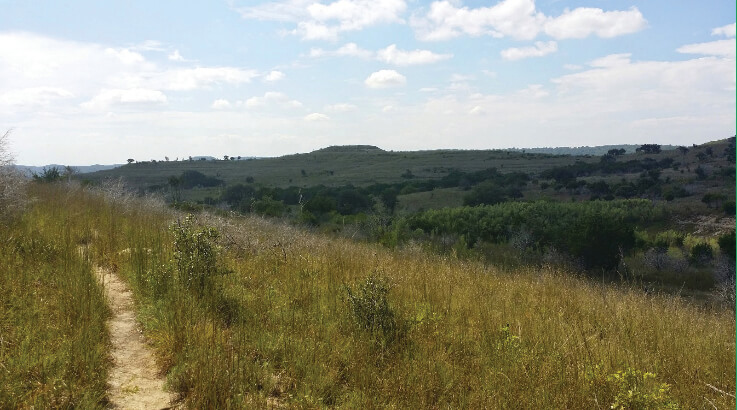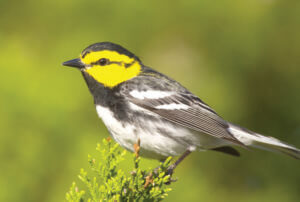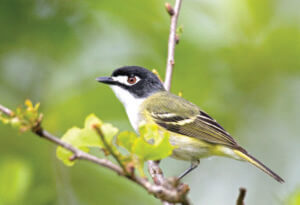
A network of trails provide public access to the Balcones Canyonlands National Wildlife Refuge — and expansive views of Hill Country — located north of Lake Travis.

Golden-cheeked Warbler
Setophaga chrysoparia
male, 2nd year bird
7 mi W of Bee Cave,
Travis Co., Texas
18 April 2007
By SARAH DOOLITTLE
Four Points News
The Balcones Canyonlands Preserve plays a huge part in area development. The 31,790 acre land preserve was established in 1996 as part of the Balcones Canyonland Conservation Plan.
“The primary purpose of preserves is wildlife habitat,” not public recreation, according to Johanna Arendt, Community Liaison for the Travis County Department of Transportation and Natural Resources.
Balcones is home to many birds and wildlife. As the saying goes, everything’s bigger in Texas, and that includes the number of bird species that can be found in the state — over 620 species, according to the Texas Ornithological Society — which is more than any other state in the U.S. The same is true throughout Texas ecosystems.
“Similar diversity is found in mammals, reptiles and plants.” Arendt added, “The loss of habitat due to development has taken its toll.”
Balcones mark in Four Points
Before the building boom in Four Points, the area was mostly private land used for ranching and cedar harvesting. Arendt describes the area as having been, “a mix of dense oak-juniper woodlands and oak-juniper savannas with heavily wooded canyons.”
Looking out across Hill Country, it is easy to imagine Comanches Indians making their homes along the Colorado River, or later, cattle ranches, thousands of acres in size, sprawling from hilltop to hilltop.
As houses, apartments and commercial developments continue their steady march across the local landscape, preserves such as the BCP ensure that some of what makes Texas great is around for future generations to behold and protect.
The intention is, “to preserve a viable ecosystem… and provide resources to a larger number of species, many of which rely on each other for food and shelter,” and in doing so allow development to proceed responsibly.
BCP history
The Balcones Canyonland Conservation Plan (BCCP), which creates a patchwork tract of land permanently protected from development, was actually founded with the intention of accelerating development in Travis County while still complying with the federal Endangered Species Act.
Individual landowners were required by the Endangered Species Act to secure individual permits from the U.S. Fish and Wildlife Department to develop their land.
In response, Arendt said, “Local policy-makers, developers, scientists and environmentalists worked together to find a workable solution” to the issue of protecting the eight endangered species living in Travis County (the golden-cheeked warbler, the black-capped vireo and six invertebrates found in caves).
As Arendt explained, instead of spending years acquiring federal permits, the BCCP allows individual landowners in much of western Travis County to pay a one-time fee to the Balcones Canyonlands Preserve BCP. “That money goes towards buying and maintaining land in the Balcones Canyonlands Preserve.”
“The BCCP was a landmark deal – the nation’s first regional multi-species habitat conservation plan,” she continued, “and has since served as a model across the country.”
Travis County and the City of Austin are the largest landowners in the BCP, though other groups, such as the Nature Conservancy, the Lower Colorado River Authority and St. Edward’s University, among others, also manage land within the BCP.
To supplement the BCP, Arendt explained, “The U.S. Fish and Wildlife Service created the Balcones Canyonlands National Wildlife Refuge north of the BCP, which currently protects (an additional) 27,500 acres.”
BCCP benefits
And while many in Four Points whose lives border the BCP complain of its limits — for example, the fact that the BCP prevents the building of an additional road behind Vandegrift High School — the BCP also provides numerous benefits to the community.
In addition to streamlining development, the BCCP fuels the local economy. “850 private landowners and developers have applied to participate through the BCCP, resulting in the development of 13,889 acres and authorization of more than 200 public infrastructure projects… (which) has brought more than $6.3 billion in assessed value to the local tax base.”
Furthermore, there are proven benefits to living near natural areas: cleaner air and water, lower flood risk, reduced stress, and improved child development.
And for those concerned with the bottom line, Arendt emphasized that, “Those views can increase property values too, benefitting both developers and homeowners.”
Community partnership
Those who, like Arendt, work to expand and preserve the BCP, know that the BCCP is most successful when it works in partnership with the communities that surround it.
To that end, BCP tracts, which are located in a historically drought-prone region, “are actively managed to reduce fire risk,” said Arendt. “One common management strategy in the Four Points area is the creation of shaded fuel breaks along preserve boundaries.” Shaded areas inhibit the growth of plants at ground level, thus reducing more flammable ground vegetation. The BCP also works to remove large areas of dead vegetation, such as junipers, where possible.
The BCP hosts some of the area’s most popular parks, including Hamilton Pool, Wild Basin, the Barton Creek Greenbelt, Emma Long, Mount Bonnell, Westcave Preserve and trails in Steiner Ranch and River Place.
Due to its delicate ecosystem, access to the rest of the BCP is tightly controlled, and “Access to some other areas is limited to guided hikes by BCP staff and volunteers,” said Arendt. “The primary purpose of preserves is wildlife habitat,” not public recreation.
Having met its land acquisition goals, “The BCCP partners still have work ahead of them,” to ensure the survival not only of endangered and threatened species but also of the biodiversity that is the hallmark of Hill Country.
Balcones Canyonlands Preserve contacts
To inquire about expanding public access to the BCP, or for general questions or concerns:
• Email to county staff at BCCP@TravisCountyTX.gov or to the BCCP Secretary at Kimberlee.Harvey@austintexas.gov
To volunteer to help maintain the BCP:
• Contact Johanna Arendt at Johanna.arendt@traviscountytx.gov or visit our website: https://www.traviscountytx.gov/tnr/bccp/hikes-vol
• Check out the City’s BCP volunteering opportunities here: http://www.austintexas.gov/bcp.
Balcones Canyonlands Preserve website:
• www.austintexas.gov/bcp
Balcones Canyonlands National Wildlife Refuge website:
•www.fws.gov/refuge/Balcones_Canyonlands/

